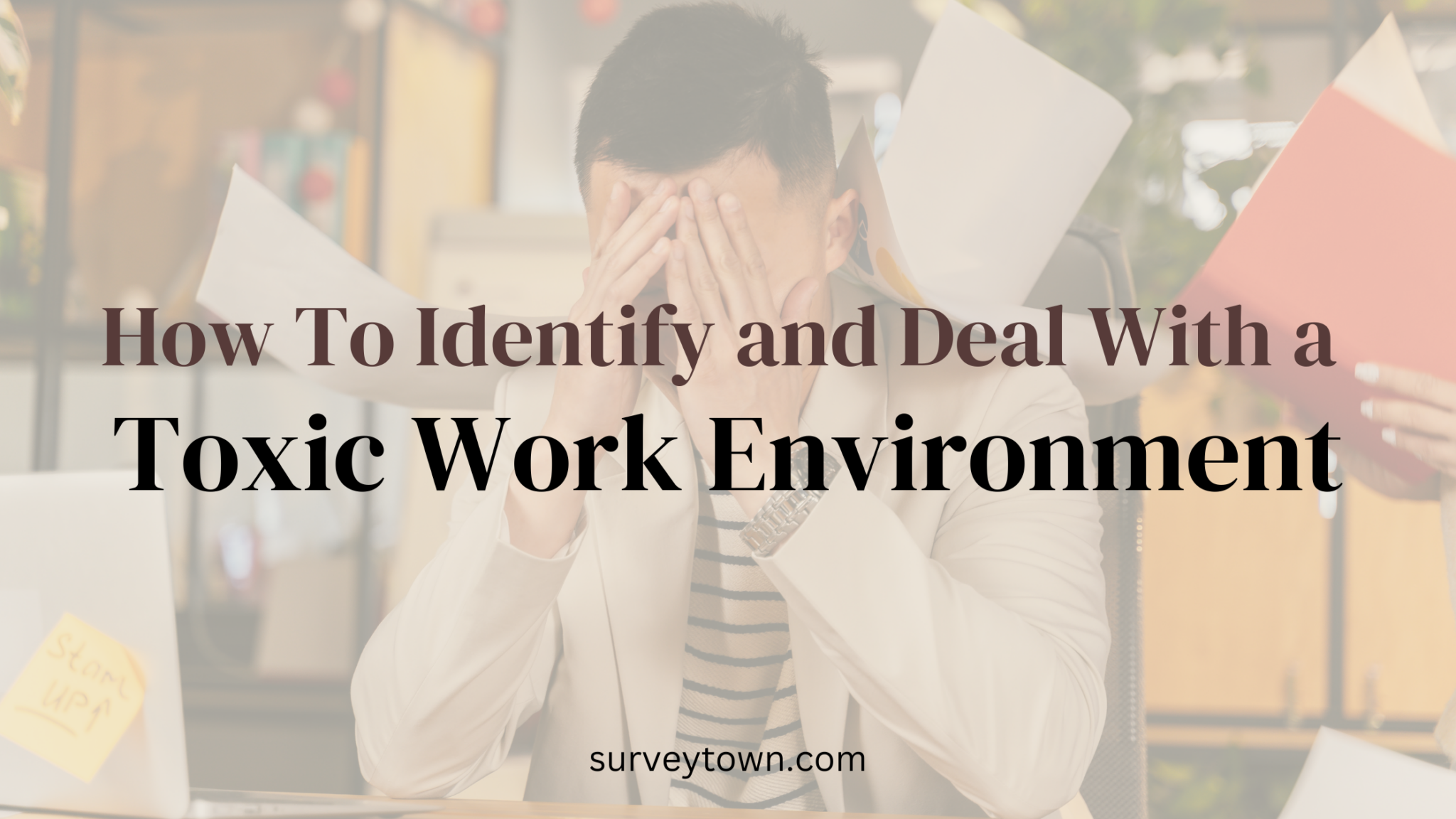Are you feeling trapped in a toxic job environment? Do you find yourself constantly drained, demotivated, or even physically ill from your work atmosphere? It’s crucial to recognize the signs of toxicity in your workplace and take action for the sake of your mental and physical health. As experts who have personally experienced and overcome such challenges, we’re here to guide you through this journey.
Firstly, let’s define what constitutes a toxic job environment. A toxic workplace is characterized by an unhealthy culture that breeds negativity, hostility, and constant stress. This poison can seep into every aspect of your professional life, affecting not only your productivity but also your overall well-being. So how do you identify if you’re stuck in a toxic work environment, and how do you deal with it? Keep reading to find answers to all your questions!
Identifying Common Signs of Toxicity
Here are the five most common signs of toxicity in the workplace:
- High turnover rate: If you notice a constant stream of employees leaving and new hires being brought in, it’s a clear sign that something is amiss within the organization. This revolving door of talent indicates an unhealthy work environment.
- Lack of communication: When there is a breakdown in communication between management and employees, misunderstandings and conflicts become all too common. Open lines of communication are crucial for fostering a positive atmosphere where everyone feels heard and valued.
- Micromanagement: Being subjected to constant monitoring and control over every aspect of your work can make you feel suffocated and hinder your productivity. A toxic job atmosphere often involves excessive micromanagement, which can be detrimental to both your mental health and career growth.
- Bullying or harassment: No one should ever tolerate any form of mistreatment, whether it be verbal or physical. Such behavior has no place in a healthy workplace culture. If you’re experiencing bullying or harassment at work, it’s important to address the issue promptly with HR or seek support from external resources.
- Lack of support or recognition: Thriving at work requires an environment where your efforts are acknowledged, appreciated, and supported by your superiors. In toxic workplaces, there is often a lack of support or recognition for employees’ hard work, leading to feelings of demotivation and dissatisfaction.
Remember that no one should have to endure toxicity at their job; prioritizing your mental health is essential. If you find yourself facing these challenges on an ongoing basis without any improvement despite efforts to handle them appropriately, it may be time to consider leaving this poisonous workplace behind.
Understanding the Impact on Your Well-Being
Working in a toxic atmosphere not only affects your mental health but also takes its toll on your physical well-being. Here are some negative effects commonly experienced:
- Increased stress levels leading to anxiety disorders
- Prolonged exposure to negativity causing depression
- Physical symptoms such as headaches, insomnia, and digestive problems due to chronic stress
By recognizing these telltale signs early on, you can proactively address toxicity within your workplace. Remember that everyone deserves to feel safe and respected at their job; enduring such conditions should never be considered acceptable.

The Psychological Impact of a Toxic Workplace
As an expert in the field, I have witnessed firsthand the devastating psychological effects that come with working in a toxic environment. It is crucial to grasp the profound connection between a toxic workplace and the detrimental impact it can have on your mental well-being.
The Connection Between a Toxic Workplace and Stress, Anxiety, and Depression
- Toxic workplaces breed an atmosphere of constant pressure, unrealistic expectations, and micromanagement, leading to sky-high stress levels.
- This chronic stress often manifests as anxiety disorders since employees are perpetually overwhelmed by their work environment.
- The negative ambiance within these toxic environments significantly contributes to feelings of depression among employees who may experience isolation or lack of support.
Long-Term Consequences of Working in a Toxic Workplace on Your Well-Being
- Prolonged exposure to toxicity at work can inflict lasting damage on your mental health.
- Chronic stress stemming from a toxic work environment has been empirically linked to various physical ailments such as heart disease, weakened immune systems, and sleep disturbances.
- Mental health issues arising from this type of workplace may persist even after leaving if not addressed promptly.
It is imperative for individuals grappling with these psychological impacts to seek assistance and take proactive steps toward improving their situation.
How To Handle a Toxic Workplace
Navigating a toxic work environment can be an arduous journey, but fear not! As an expert in the field, I’m here to provide you with invaluable strategies to handle the poison and safeguard your mental well-being. Let’s dive into some essential tips for tackling a toxic workplace head-on:
Prioritize Your Mental Health
- Embrace self-care: Engage in activities outside of work that bring you immense joy and help you unwind. Not only will engaging in such activities improve your overall well-being, but it will also provide a much-needed escape.
- Establish boundaries: Clearly define the line between your personal life and professional commitments to prevent burnout. By setting limits on how much time you dedicate to work-related tasks, you can ensure that there is still room for relaxation, hobbies, and time with loved ones.
- Seek support: Reach out to trusted friends and family members, or even consider seeking guidance from a therapist during challenging times.
Assess Your Options
- Assess the situation: Begin by evaluating whether the toxicity in your workplace is a temporary issue or deeply ingrained within the organization’s culture. Take the time to delve into the root causes and consider how involved leadership is in addressing this matter.
- Utilize internal resources: Make use of any employee assistance programs or counseling services that your company offers. Additionally, seek guidance from HR or your immediate supervisor, as they can provide valuable insights, advice, and additional resources to help you effectively navigate through this challenging situation.
- Explore alternative departments or teams: If possible, explore opportunities within your organization that may offer a healthier work environment. This shift not only has the potential to improve your work-life balance but also reignite your passion for your career.
Remember, toxic workplaces can have detrimental effects on both mental and physical health. It’s crucial to prioritize yourself and seek out solutions that will allow you to thrive professionally while maintaining overall well-being.
Communicate Effectively
- Express concerns professionally: When addressing issues with colleagues or superiors, maintain composure and clearly articulate your concerns without becoming defensive.
- Utilize “I” statements: Frame conversations around how certain behaviors make you feel rather than directly accusing others.
Document Incidents
Keep meticulous records of any instances of harassment, discrimination, or other toxic behaviors you witness or experience. These serve as crucial evidence and can greatly support your case if you ever need to take action. When documenting these incidents, be sure to include specific details such as dates, times, locations, individuals involved, and thorough descriptions of each incident.
Not only does keeping detailed records validate your experiences, but it also provides a clear picture of the toxicity within your workplace culture. By having this information readily available, you empower yourself with concrete evidence should the need arise to address these issues formally.
Seek Legal Guidance if Necessary
If all else fails and toxicity persists despite your best efforts to address it internally, consult an employment lawyer who specializes in workplace issues for expert advice on potential legal action.

Remember that every individual’s circumstances are unique; what works for one person may not necessarily work for another in handling a toxic workplace. Trust your instincts and prioritize your well-being above all else. With these expert tips, you’ll be equipped to navigate the challenges and emerge stronger on the other side.
Seeking Professional Help
Recognizing the signs of a toxic workplace is absolutely crucial for your overall well-being. However, sometimes it’s not enough to simply identify the problem on your own. In certain situations, seeking professional help becomes necessary in order to effectively address the issues and find a resolution that works for you. Here are some important points to consider when determining if professional assistance is needed in handling a toxic work environment:
Exploring Therapy and Counseling Options
If you constantly find yourself feeling stressed, anxious, or depressed due to your work atmosphere, it may be highly beneficial to seek therapy or counseling from an experienced professional. They can provide invaluable guidance and support as you navigate through the challenges associated with working in a toxic workplace.
Understanding HR’s Role
Human Resources (HR) departments play a vital role in addressing workplace issues. If you feel comfortable doing so, don’t hesitate to reach out to HR and discuss your concerns regarding toxicity within your organization. They should have established policies and procedures specifically designed to handle such situations.
Considering Legal Recourse
In extreme cases where harassment or discrimination is involved, consulting with an employment lawyer about potential legal action against your employer may become necessary. It’s important to approach this step after careful consideration and consultation with professionals who specialize in employment law.
Seeking Advice From Career Coaches or Mentors
Career coaches or mentors possess valuable insights into navigating challenging work environments successfully. They can offer expert guidance on how best to handle specific situations while helping you develop effective strategies for coping with toxicity without compromising your long-term career goals.
Remember that seeking professional help does not equate to admitting defeat; rather, it demonstrates strength and determination in taking control of your own well-being amidst difficult circumstances.
Creating a Positive Work Environment
As an expert in the field, I have witnessed firsthand the detrimental effects of toxicity in the workplace. That’s why it is crucial to focus on creating a positive work environment that not only benefits employees but also contributes to the overall success of an organization. Allow me to share with you some invaluable tips that can help you foster a positive and healthy work culture:
Set an Example
Leadership sets the tone for the entire atmosphere of a workplace. By embodying positivity, respect, and empathy towards your team members, you inspire others to follow suit.
Encourage Open Communication
Establish clear channels of communication that empower employees to freely express their thoughts, concerns, and ideas. This fosters collaboration and creates an inclusive environment where everyone feels valued.
Promote Work-Life Balance
Recognize that employees have lives outside of work and encourage them to maintain a healthy equilibrium between their personal and professional commitments. Offer flexible working hours or remote options whenever feasible.
Provide Growth Opportunities
Invest in employee development programs that enable individuals to enhance their skills and advance within the organization. When employees feel supported in their career aspirations, they become more engaged and motivated.
Foster Teamwork and Collaboration
Cultivate teamwork by promoting cross-functional projects or engaging in team-building activities that foster camaraderie among colleagues. Collaboration enhances creativity, problem-solving abilities, and overall productivity.
Recognize Achievements
Regularly celebrate individual accomplishments as well as team successes through recognition programs or rewards systems. Acknowledging hard work boosts morale while motivating employees to continue performing at their best.
Support Diversity & Inclusion Initiatives
Embrace diversity within your workforce by implementing policies that promote inclusivity across all levels of your organization. This includes ensuring equal opportunities for advancement regardless of gender, race, or background. Encouraging diverse perspectives leads to innovation and cultivates a dynamic work environment.
Prioritize Employee Well-Being
Encourage a healthy work-life balance by offering wellness programs, such as yoga classes or mental health resources. By prioritizing the physical and mental health of your employees, you create a supportive atmosphere where they can thrive.
Address Conflicts Promptly
Toxicity often stems from unresolved conflicts within the workplace. As a leader, it is crucial to address any issues or disputes promptly and impartially. Implement conflict resolution strategies that encourage open dialogue and mediation.
Continuously Evaluate and Improve
Regularly assess the effectiveness of your efforts in creating a positive work culture through surveys, feedback sessions, or anonymous suggestion boxes. Utilize this valuable feedback to identify areas for improvement and implement necessary changes.
By implementing these expert tips, you can transform toxic workplaces into thriving environments where employees feel valued, supported, and motivated to do their best work. Remember that creating a positive work culture is an ongoing process that requires commitment from all levels of the organization. Together, we can foster an atmosphere where individuals flourish both personally and professionally while achieving remarkable success.




